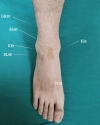Comparative Efficacy of Micro-Needle-Knife Therapy and Acupuncture in Acute Ankle Sprains: A Randomized Controlled Trial
- PMID: 38794788
- PMCID: PMC11135136
- DOI: 10.12659/MSM.944157
Comparative Efficacy of Micro-Needle-Knife Therapy and Acupuncture in Acute Ankle Sprains: A Randomized Controlled Trial
Abstract
BACKGROUND Micro-needle knife (MNK) therapy releases the superficial fascia to alleviate pain and improve joint function in patients with acute ankle sprains (AAS). We aimed to evaluate the efficacy and safety of MNK therapy vs that of acupuncture. MATERIAL AND METHODS This blinded assessor, randomized controlled trial allocated 80 patients with AAS to 2 parallel groups in a 1: 1 ratio. The experimental group received MNK therapy; the control group underwent conventional acupuncture treatment at specified acupoints. Clinical efficacy differences between the 2 groups before (time-point 1 [TP1]) and after treatment (TP2) were evaluated using the visual analogue scale (VAS) and Kofoed ankle score. Safety records and evaluations of adverse events were documented. One-month follow-up after treatment (TP3) was conducted to assess the intervention scheme's reliability. RESULTS VAS and Kofoed ankle scores significantly improved in both groups. No patients dropped due to adverse events. At TP1, there were no significant differences between the 2 groups in terms of VAS and Kofoed scores (P>0.05). However, at TP2, efficacy of MNK therapy in releasing the superficial fascia was significantly superior to that of acupuncture treatment (P<0.001). At TP3, no significant differences in scores existed between the groups (P>0.05). CONCLUSIONS This study demonstrates that 6 sessions of MNK therapy to release the superficial fascia safely and effectively alleviated pain and enhanced ankle joint function in patients with AAS, surpassing the efficacy of conventional acupuncture treatment. Future studies should increase the sample size and introduce additional control groups to further validate the superior clinical efficacy of this intervention.
Conflict of interest statement
Figures







Similar articles
-
Add-on effect of kinesiotape in patients with acute lateral ankle sprain: a randomized controlled trial.Trials. 2020 Feb 12;21(1):176. doi: 10.1186/s13063-020-4111-z. Trials. 2020. PMID: 32051009 Free PMC article. Clinical Trial.
-
The effects of Kinesiotape on acute lateral ankle sprain: study protocol for a randomized controlled trial.Trials. 2018 Feb 20;19(1):125. doi: 10.1186/s13063-018-2527-5. Trials. 2018. PMID: 29458399 Free PMC article.
-
TA pharmacopuncture as a primary and independent treatment for frequent sprains occurring over 9 months in a patient with needle sickness: Case report.Medicine (Baltimore). 2018 Nov;97(45):e13123. doi: 10.1097/MD.0000000000013123. Medicine (Baltimore). 2018. PMID: 30407331 Free PMC article.
-
Acupressure Therapy for Acute Ankle Sprains: A Randomized Clinical Trial.PM R. 2018 Jan;10(1):36-44. doi: 10.1016/j.pmrj.2017.06.009. Epub 2017 Jun 19. PM R. 2018. PMID: 28634002 Clinical Trial.
-
Clinical Evidence of Bee Venom Acupuncture for Ankle Pain: A Review of Clinical Research.Toxins (Basel). 2025 May 21;17(5):257. doi: 10.3390/toxins17050257. Toxins (Basel). 2025. PMID: 40423339 Free PMC article. Review.
Cited by
-
Needle knife therapy combined with chinese herbal medicine in the treatment of knee osteoarthritis: a meta-analysis.Am J Transl Res. 2024 Dec 15;16(12):7238-7247. doi: 10.62347/VGCJ2742. eCollection 2024. Am J Transl Res. 2024. PMID: 39822562 Free PMC article. Review.
-
The Clinical Effect of Electroacupuncture Combined with Surround Needling in the Treatment of Acute Lateral Ankle Sprain Based on Musculoskeletal Ultrasound Imaging Technology: A Protocol for a Single-Centre, Randomized, Controlled Trial.J Pain Res. 2025 May 15;18:2467-2478. doi: 10.2147/JPR.S517109. eCollection 2025. J Pain Res. 2025. PMID: 40391277 Free PMC article.
References
-
- Delahunt E, Bleakley CM, Bossard DS, et al. Clinical assessment of acute lateral ankle sprain injuries (ROAST): 2019 consensus statement and recommendations of the International Ankle Consortium. Br J Sports Med. 2018;52(20):1304–10. - PubMed
-
- Altomare D, Fusco G, Bertolino E, et al. Evidence-based treatment choices for acute lateral ankle sprain: A comprehensive systematic review. Eur Rev Med Pharmacol Sci. 2022;26(6):1876–84. - PubMed
Publication types
MeSH terms
LinkOut - more resources
Full Text Sources
Medical

